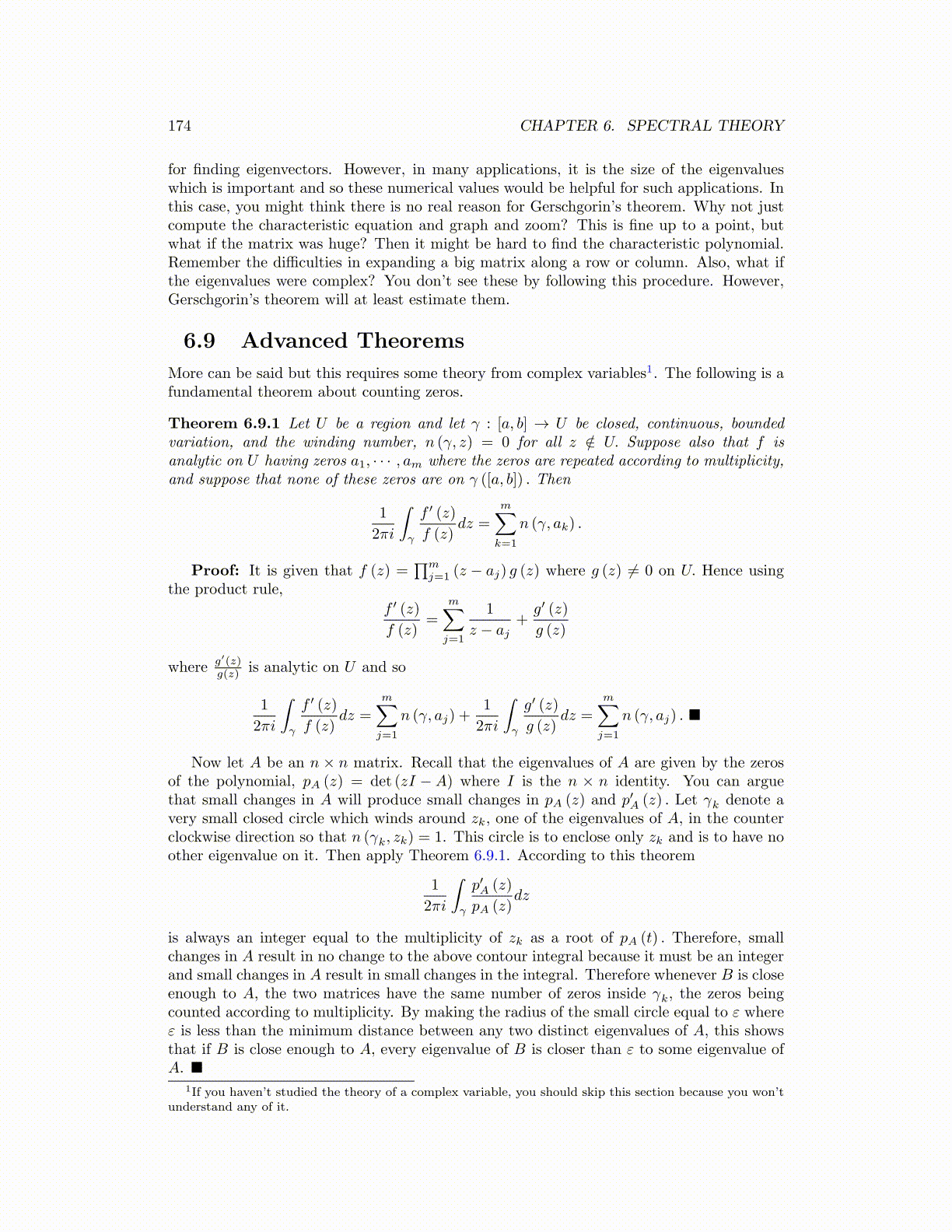
174 CHAPTER 6. SPECTRAL THEORY
for finding eigenvectors. However, in many applications, it is the size of the eigenvalueswhich is important and so these numerical values would be helpful for such applications. Inthis case, you might think there is no real reason for Gerschgorin’s theorem. Why not justcompute the characteristic equation and graph and zoom? This is fine up to a point, butwhat if the matrix was huge? Then it might be hard to find the characteristic polynomial.Remember the difficulties in expanding a big matrix along a row or column. Also, what ifthe eigenvalues were complex? You don’t see these by following this procedure. However,Gerschgorin’s theorem will at least estimate them.
6.9 Advanced Theorems
More can be said but this requires some theory from complex variables1. The following is afundamental theorem about counting zeros.
Theorem 6.9.1 Let U be a region and let γ : [a, b] → U be closed, continuous, boundedvariation, and the winding number, n (γ, z) = 0 for all z /∈ U. Suppose also that f isanalytic on U having zeros a1, · · · , am where the zeros are repeated according to multiplicity,and suppose that none of these zeros are on γ ([a, b]) . Then
1
2πi
∫γ
f ′ (z)
f (z)dz =
m∑k=1
n (γ, ak) .
Proof: It is given that f (z) =∏m
j=1 (z − aj) g (z) where g (z) ̸= 0 on U. Hence usingthe product rule,
f ′ (z)
f (z)=
m∑j=1
1
z − aj+g′ (z)
g (z)
where g′(z)g(z) is analytic on U and so
1
2πi
∫γ
f ′ (z)
f (z)dz =
m∑j=1
n (γ, aj) +1
2πi
∫γ
g′ (z)
g (z)dz =
m∑j=1
n (γ, aj) . ■
Now let A be an n × n matrix. Recall that the eigenvalues of A are given by the zerosof the polynomial, pA (z) = det (zI −A) where I is the n × n identity. You can arguethat small changes in A will produce small changes in pA (z) and p′A (z) . Let γk denote avery small closed circle which winds around zk, one of the eigenvalues of A, in the counterclockwise direction so that n (γk, zk) = 1. This circle is to enclose only zk and is to have noother eigenvalue on it. Then apply Theorem 6.9.1. According to this theorem
1
2πi
∫γ
p′A (z)
pA (z)dz
is always an integer equal to the multiplicity of zk as a root of pA (t) . Therefore, smallchanges in A result in no change to the above contour integral because it must be an integerand small changes in A result in small changes in the integral. Therefore whenever B is closeenough to A, the two matrices have the same number of zeros inside γk, the zeros beingcounted according to multiplicity. By making the radius of the small circle equal to ε whereε is less than the minimum distance between any two distinct eigenvalues of A, this showsthat if B is close enough to A, every eigenvalue of B is closer than ε to some eigenvalue ofA. ■
1If you haven’t studied the theory of a complex variable, you should skip this section because you won’tunderstand any of it.